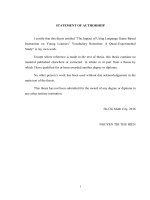BHS Thesis Main part
Bạn đang xem bản rút gọn của tài liệu. Xem và tải ngay bản đầy đủ của tài liệu tại đây (134.99 KB, 6 trang )
PART A: INTRODUCTION
i. Rationale
“One’s eyes are more accurate witnesses than ears”
Heraclitus
To our understanding, language is a great heaven prize and treasure for human in order to
fulfill our vital needs as the social beings: communication. Language appeared, remains and
flourishes along with human history. With the seen development of language and language
studies at the moment, there is no need in proving the crucial and irreplaceable position of
language in human life.
However, there are now more and more researchers believing that communication without
spoken and written words, termed “nonverbal communication” (NVC), is of vital role. As
Heraclitus states above, people tend to rely on NVC and to base the partners’ message on the
nonverbal cues they receive. One more important thing is that even nonverbal
communication takes a big part in transferring meaning in communication; most people do
not know how to read other’s behaviors. Thus, the question is: what shape our behaviors and
decision? For a successful communication event, one possible answer is emotion.
Therefore, the studies into nonverbal expressions for internal emotions have been paid much
attention to. The primary emotional states studied include: surprise, fear, disgust, anger,
sadness and happiness. Nevertheless, disappointment, one of two primary emotions (together
with regret) that involve in decision-making – the success of a communication event, has not
been much concerned.
All of this leads the author to the research naming: “An American – Vietnamese cross-
cultural study on non-verbal expressions of disappointment”. This preliminary study
tries to feature out the most common nonverbal expressions for disappointment in order that
a successful communication event can be achieved between American and Vietnamese
communicators.
ii. Aims of the study
This research aims to:
- investigate the most common nonverbal expressions for disappointment used by Americans
and Vietnamese in cross-cultural communication.
1
- raise the awareness of the importance of NVC and suggest ways to improve cross-cultural
NVC.
In order to achieve the set aims of the study the research questions are as follows:
- What are the most common nonverbal expressions for disappointment used by Americans
and/or Vietnamese?
- What are the similarities and differences between American and Vietnamese nonverbal
expressions of disappointment?
iii. Scope of the study
Nonverbal messages are widely transferred through many channels. For the common
consideration, it includes: paralanguage, body language, object language and environment
language, of which object language and environment language do not have much
contribution to express emotions which include disappointment. It comes to our awareness
that paralanguage (the vocal characteristics, types of vocal flow, vocal interferences,
silence…) adds a high percentage to the process of communication. However, due to the
time constraint and lack of reliable equipment (voice recorder, voice analyzer…), this kind
of factor will be unavoidably out of the scope of the study.
So, the study only focuses on body language. That is, this study limits itself to facial
expressions, gestures and postures only.
iv. Methods of the study
In order to set up a firm theoretical background for the study, relevant publications are
critically reviewed. Information from the Internet sites and previous studies are also referred
to.
The main method used in this study is quantitative with the illustration of tables and charts
presenting statistic data. The analysis is mainly based on the data collected through the
survey questionnaires.
Consultation with the supervisor, discussion with colleagues, as well as the author’s
observation in daily life and his own experience in cross-cultural communication are also of
great help in finding out the answers to the research questions.
2
v. Organization of the study
The study will be organized into the following structure:
Part A: INTRODUCTION outlines the rationale, the methodology, the aims, the scope, the
significance and the organization of the study.
Part B: DEVELOPMENT
Chapter 1 LITERATURE REVIEW reviews the theoretical issues. It briefly presents and
discusses the theory of communication, NVC with more detailed discussion on facial
expressions, gestures and postures which are major parts of body language. Disappointment
as a human feeling and its nonverbal expressions are also discussed.
Chapter 2 METHODOLOGY describes the data collecting instrument, the informants and
research procedures.
Chapter 3 DATA ANALYSIS AND DISCUSSIONS OF THE FINDINGS presents and
discusses similarities and differences in how to express disappointment nonverbally by the
American and the Vietnamese.
Part C: CONCLUSION
Summary of major findings
Conclusion and Implications for cross-cultural communication
Limitations of the study and Suggestions for further study.
3
PART B: DEVELOPMENT
CHAPTER 1 LITERATURE REVIEW
1.1. CULTURE
As Harrison and Huntington noted, “the term ‘culture,’ of course, has had different meanings
in different disciplines and different contexts”. By stating “culture is the human-made part of
the environment,” W.J.Lonner and R.S.Malpass (1994:7) contrast the culture and the nature.
In their ideas, things in environment will never become cultural without the “touch” of
human.
According to H. Triandis (1994:23), “Culture is a set of human-made objective and
subjective elements that in the past have increased the probability of survival and resulted in
satisfaction for the participants in a ecological niche, and this became shared among those
who could communicate with each other because they had a common language and they
lived in the same time and place.” The subjective elements of culture here are elements such
as values, attitudes, beliefs, orientations and underlying assumptions prevalent among people
in a society. All of these elements act as a framework that influences your interpretation of
the world and interactions in it.
1.2. COMMUNICATION
1.2.1. Definition of Communication
“We are great communicators”
Liz & John Soars: 1997
We, human beings, communicate during our whole life for our own purpose. A child cries
(communicates) to his parents as he needs changing his diaper or feeding. Family members
communicate for help and emotional support and to maintain a good family atmosphere. At
work, people communicate for the purpose of exchanging ideas, negotiating… Leaders
communicate their visions to their staff. Executives communicate to the lower-level
employees. Organizations communicate to their customers and the public. Press conferences,
press releases, employee newsletters, catalogues, direct mail, phone calls, employee
suggestion systems, meetings, formal performance appraisals, on-the-job feedback from
managers, attitude surveys, speeches, conference room briefings, letters, memos and
4
evaluation forms - all of these are examples of communication. We now come to a
conclusion that communication is very important in our lives, as Hybels (1992:5) claims
“Communication, then, is vital to our lives. To live is to communicate.”
Larry A., Richard E. Porter and Edwin R. McDaniel (2006:12) select the all-encompassing
definition of “human communication is the process through which symbols are transmitted
for the purpose of eliciting a response”. Lustig (1996:29) defines communication as “a
symbolic process in which people create shared meanings”. In the both definitions, the
centre is “symbol”. A symbol may be “a word, action or object”, containing thoughts,
perception or feelings one wants to communicate with others.
1.2.2. Forms of Communication
Communication as claimed by Lustig above is the process of exchange shared meanings.
And in order to create share meaning, people have to use code or symbol. In reality, the two
kinds of code or symbol are verbal (spoken and written) and nonverbal (unspoken). These
are referred to as forms of communication.
To get a better view, communication can be illustrated in the following diagram:
1.2.3. Components of Communication
The followings are components of communication according to Hymes: 1972.
- Situation: setting and sense
- Participants: speaker, presenter, hearer, receiver, narrator
- End: purpose, result or goal
- Act sequences: model or language content
- Key: Clues that establish the "tone, manner, or spirit" of the speech act.
- Instrumentalities: channel, form or style
- Norms: norms of interpretation, norms of interaction
- Genres: kind of speech act or event
COMMUNICATION
VERBAL COMMUNICATION NONVERBAL COMMUNICATION
5









